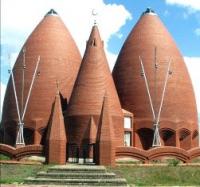You are here
Complex of Karasay and Agyntay batyr in village Madeniet.

Sightseeing trips in the North Kazakhstan region.
“Death with glory and honor is not a sacrifice, but a feat”
Konstantin Fedin.
Architectural monuments of the North Kazakhstan region.
The memorial complex Karasay and Agyntay Batyr in the village of Madeniyet, Ayrtau district in the North Kazakhstan region, was established on October 15, 1999. The architects of the complex are Bek Ibraev and Sadvokas Agitaev.
The memorial complex compositionally develops the traditions of the ancient Turkic rates of kagans. The entire complex is oriented with its main axis to Mecca, where the ledge of the mihrab of the mosque is directed.
Compositionally, the complex figuratively develops the traditions of the ancient Turkic rates of kagans. Buildings in the form of two combat helmets are installed on a high hill, between them is a mosque. Nearby are the crossed spears of ancient warriors.
Around the domes are several more burials of ancient warriors. For pilgrims and tourists there is a hotel next to the mausoleum. The entrance to the circle, fenced with a brick fence, is distinguished by two towers and leads to the platform in front of the mausoleum, intended for prayer and sacrifice of a ram.
In the corners of the site on granite bases, crossed spears of a metal profile with bronze plates are installed as symbols of military prowess. In the center of the circle are two batyr mausoleums of ellipsoidal outlines characteristic of Northern Kazakhstan.
Before them is a small cone-shaped memorial mosque symbolically uniting the mausoleums. In the center between the mausoleums is a small pinakothek, where texts in three languages are written on the walls, telling about the heroic deeds of the batyrs.
The majestic volumes of the mausoleums in the upper part are inlaid with ceramic irrigation cladding elements and end with domes of 6 mm curved glass on a metal frame. Between the glass and the walls there is a ventilation slot for drying the dome.
The doors to the mausoleum are made of metal, with overlays of carved brass coated with gold texts from the Koran. Ceramic bricks, Kurtinsky and Kurdish granite are used in interior decoration. Tombstones, continuing the ancient Turkic tradition of installing kulpytas and koytas over a burial place, are made of polished red Kurdish granite according to the authors' templates.
Each tombstone has a shyrak, lighting it, visitors can turn to the Aruahs (spirits) for help. Other existing graves within the district are paved with paving slabs, outside they are surrounded by a low forged metal fence.
All the main structures of the memorial are made of ceramic bricks with a brand of at least 100, made according to Italian technology. Monolithic reinforced concrete belts run along the top of the walls to eliminate the spread of domes.
The top of the inter-domed room is covered with a layer of waterproofing - impregnation with a hydroisol and a plastic film, with a protective layer of brick laid flat. The floors and the surface of the site in front of the mausoleum are made of paving slabs.
The area in front of the complex is tiled with natural stone, benches for relaxation, lamps on racks made of cast iron are installed. Dimensions of the main elements of the complex: the height of the mausoleums is 16 meters, the mosque is 12 meters, the dimensions of the structure in the plan are 19 x 13.5 meters, the diameter of the fence circumference is 27 meters.
Authority:
“Based on field research. Ermaganbetova K. December 2016. "Register of memorial complexes built during the period of independence." "Practices and places of memory in Kazakhstan." Medeuova K.A., Sandybaeva U.M., Naurzbaeva Z.Zh., Tolgambaeva D.T., Ermaganbetova K.S., Melnikov D.N., Kikimbaev M.Zh., Ramazanova A.Ch., Tlepbergen A .B., Zhetibaev E.Zh., Orazbaeva D.E., Poltavets K.A.







